 Emily LaBarge
Emily LaBarge
Across a series of new paintings by the artist, repeated palettes and motifs playfully inspire a questioning of perception and expectation.
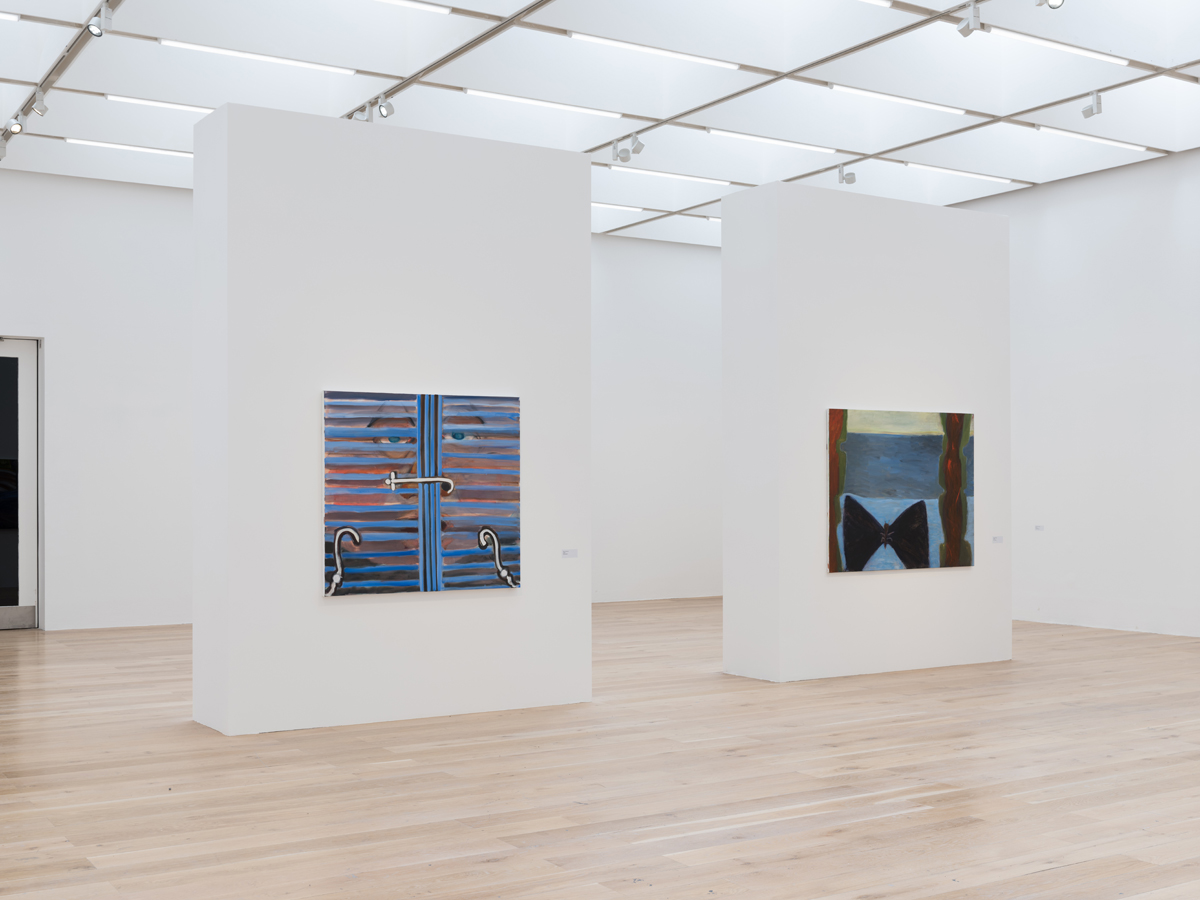
Rosalind Nashashibi: Hooks, installation view. Courtesy Nottingham Contemporary. © Lewis Ronald. Pictured, left: Blue Shutters, 2022.
Rosalind Nashashibi: Hooks, curated by Sam Thorne, Nottingham Contemporary, Weekday Cross, Nottingham, United Kingdom,
through May 7, 2023
• • •
There are different terms for it—the way something lingers in the mind, niggles the senses, runs round and round, seeking, perhaps, some outlet or reincarnation. You might call it an earworm (a calque of the German Ohrwurm, an infectious tune, e.g., “I just can’t get you out of my head”), a hobbyhorse, Tetris effect, idée fixe, mind pop, afterimage, or even a haunting. “Whenever you start to make a painting or decide on shots in a film,” the artist Rosalind Nashashibi has said, “there are lots of other paintings and films running through your head.” Her largest UK exhibition of paintings to date takes its title from the intuitive process by which she distills the emergent “hook” of a preoccupying motif within the “charged field of activity” that constitutes the medium.
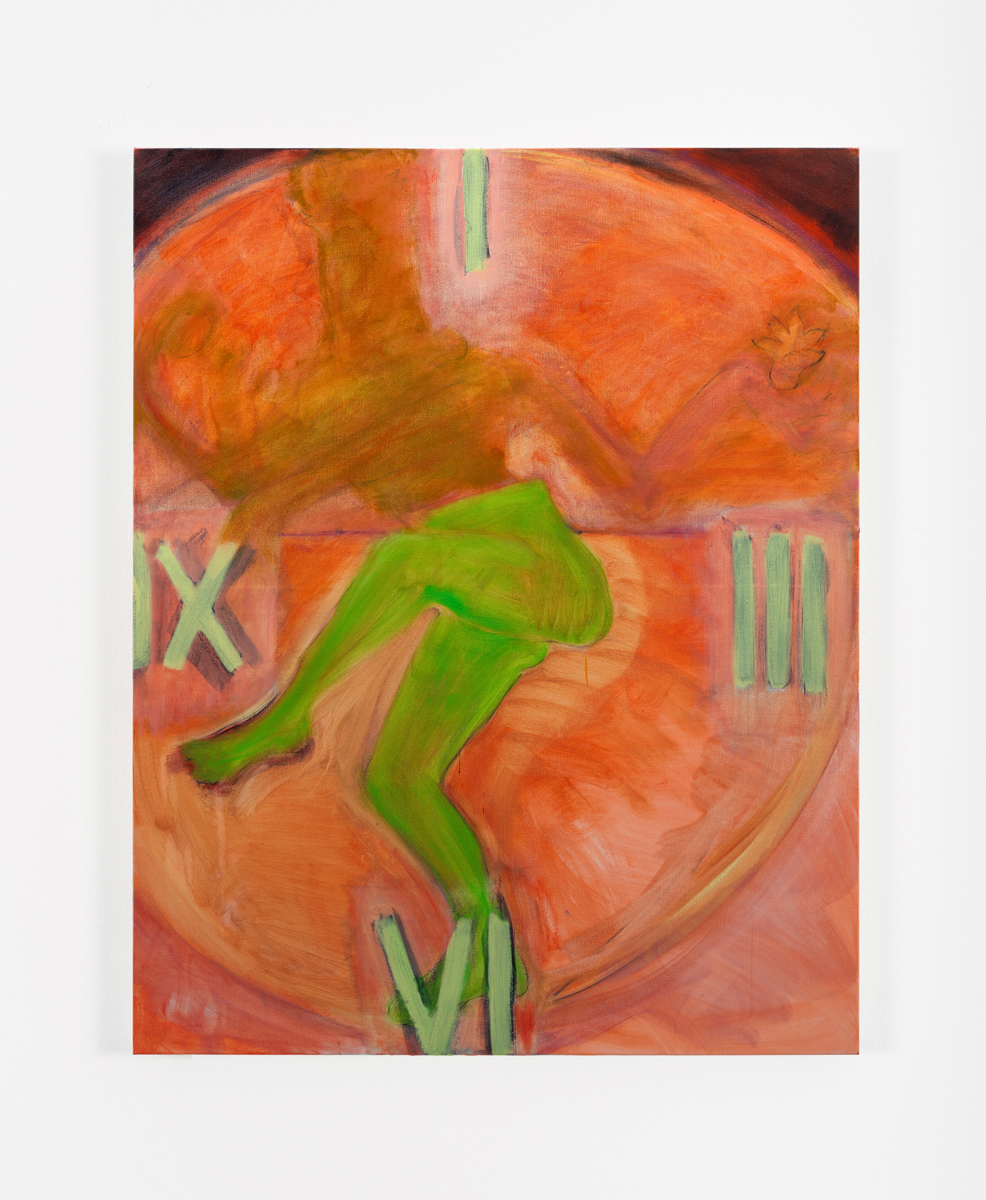
Rosalind Nashashibi, Clockdancer, 2020. Oil on canvas. Courtesy the artist and GRIMM. © Rosalind Nashashibi.
Across fifteen pieces of varying sizes, hooks are both literal and figurative (or, given their painterly nature, I suppose, figurative and figurative). Rest Before Change and Blue Shutters (both 2022) show the interior of European-style shutters, each locked at the midpoint with a hook. In the former, one shutter is colored dusky indigo while the other is mauve-gray, both striped with faint white horizontals. The two flanks, flush with the canvas edges, are separated centrally by a vibrant stripe of yellow and white that is edged in black and fixed in the middle with a curving bright-white latch whose hook is deliciously limned with aquamarine. What might otherwise read as abstraction is fastened back to reality with simple hardware.
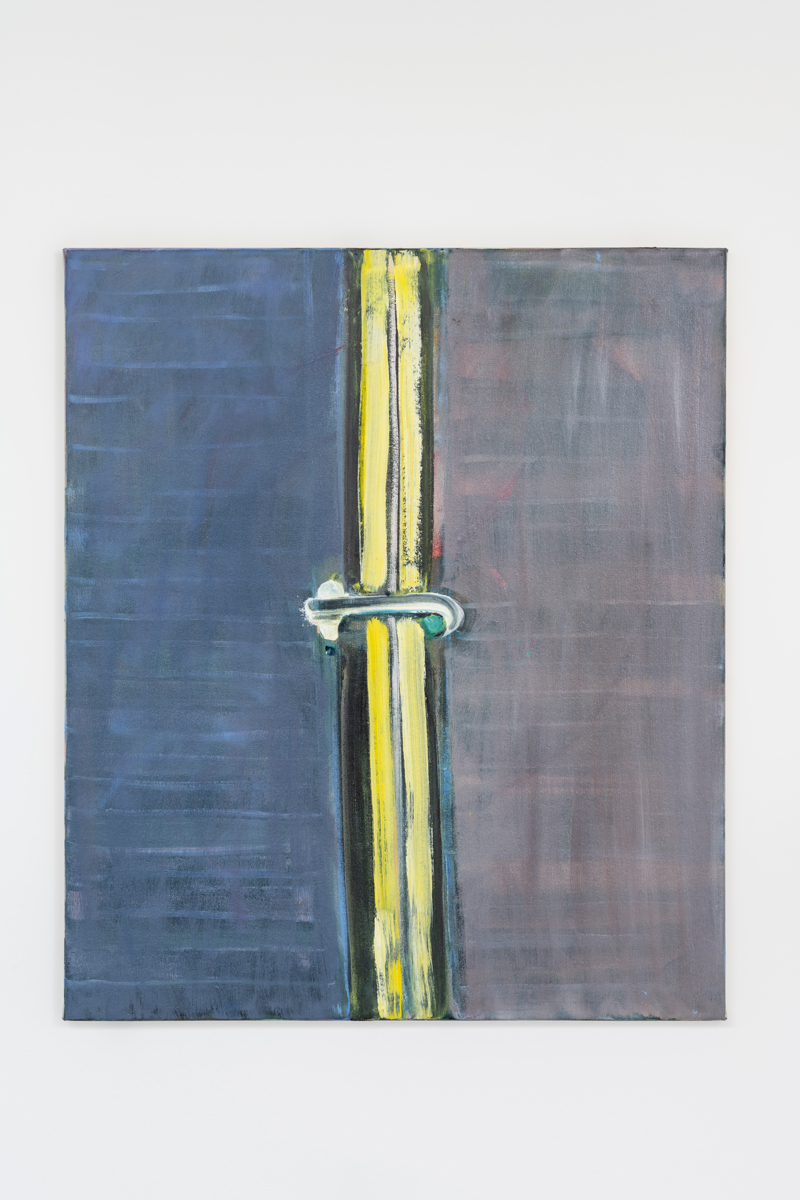
Rosalind Nashashibi, Rest Before Change, 2022. Oil on linen. Courtesy the artist and GRIMM. © Rosalind Nashashibi.
In the second work, the cobalt-blue shutters are closed with a white latch outlined cartoonishly in black, with two additional white latches (“shutter dogs” is the technical term for these architectural implements used to keep the coverings open) that curl up from the corners like question marks about what is underway. Beyond the slightly parted slats looms a giant fleshy face, with rosy cheeks and watery blue eyes, peering directly into what might be the painter’s room, but here is the gallery in which we stand. How big is this person? (How small is this window?!) Who is it and what do they want? Have we caught the slats mid-open or -close? In Nashashibi’s art, narrative detail matters less than the evocation of atmosphere, sensibility, and mood.
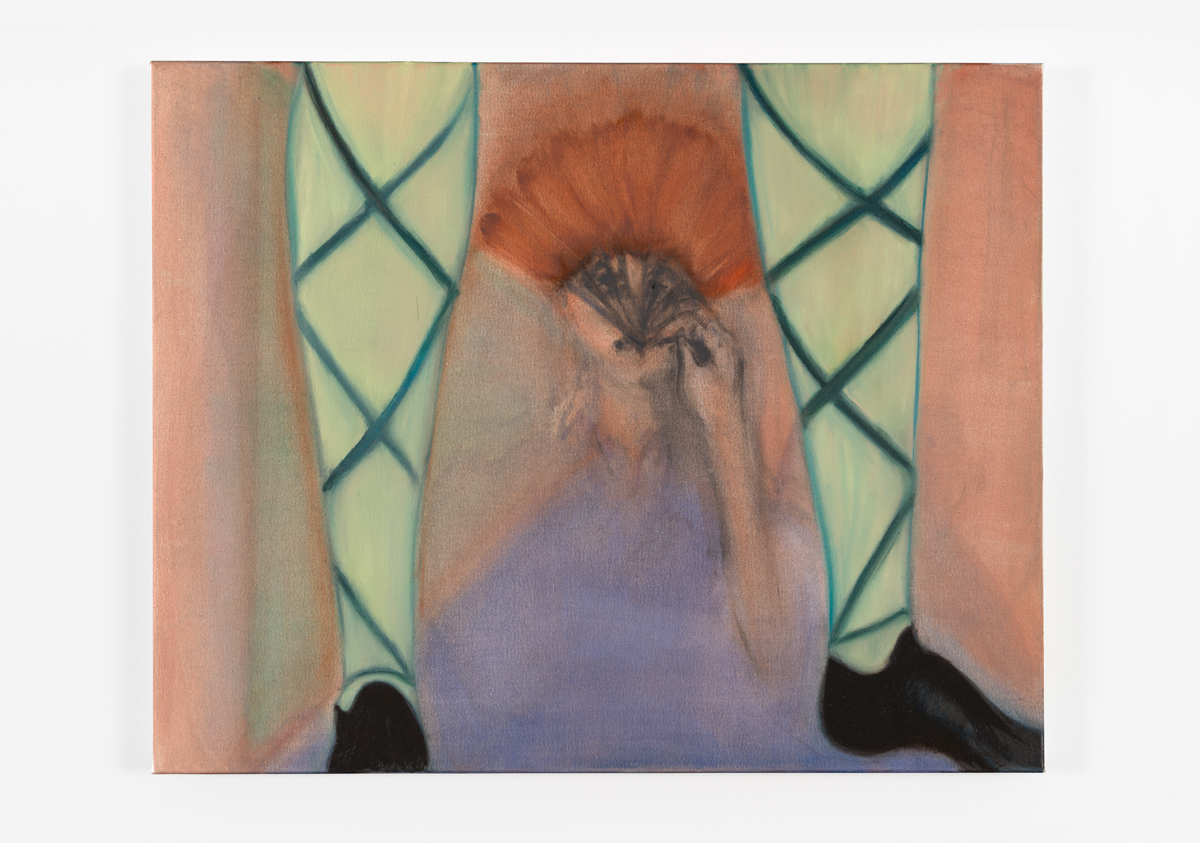
Rosalind Nashashibi, Phosphorous Malvolio, 2022. Oil on canvas. Courtesy the artist and GRIMM. © Rosalind Nashashibi.
In other works, the “hooks” are images and details that repeat throughout the sparely hung canvases and echo each other in looping, associative chains. Recurrent forms are sometimes identical (dogs, clocks, legs, brick walls, handheld fans) and sometimes subtle pseudomorphic transmogrifications (moths and bowties, latches and striped fabric, pillars and curtains). Other connections are stylistic and technical—a soft palette that is warm, tinged with rose or peach, even when suffused by cool blues, purples, and greens; the thin and loose application of oil paint so that the fibers of the support beneath, particularly when linen, lend a tactility to the compositions; the use of framing devices to guide, delimit, and destabilize vision. Shone Upon (2022) shows a brick wall with a large, messily painted rectangle sitting in its center; from the shape descend three long strokes, like supportive legs, reaching to the bottom edge of the canvas. It could be a window, shutters, a poster, a freestanding screen. It could be a play on the figurative versus the abstract—a vivid muddy-green cataract that forces us to engage with the two genres simultaneously. “It’s very hard to unlock how to look at something,” Nashashibi has said, perhaps hinting at how her paintings playfully confound expectations, conjuring in-between states of both body and mind. Painting is about marshaling space, about learning and unlearning how and why and what we see within the constructed image as within the wider world; it hangs (so to speak) between the fabricated and the real, and we apprehend both at once in pictures that are as familiar as they are strange.
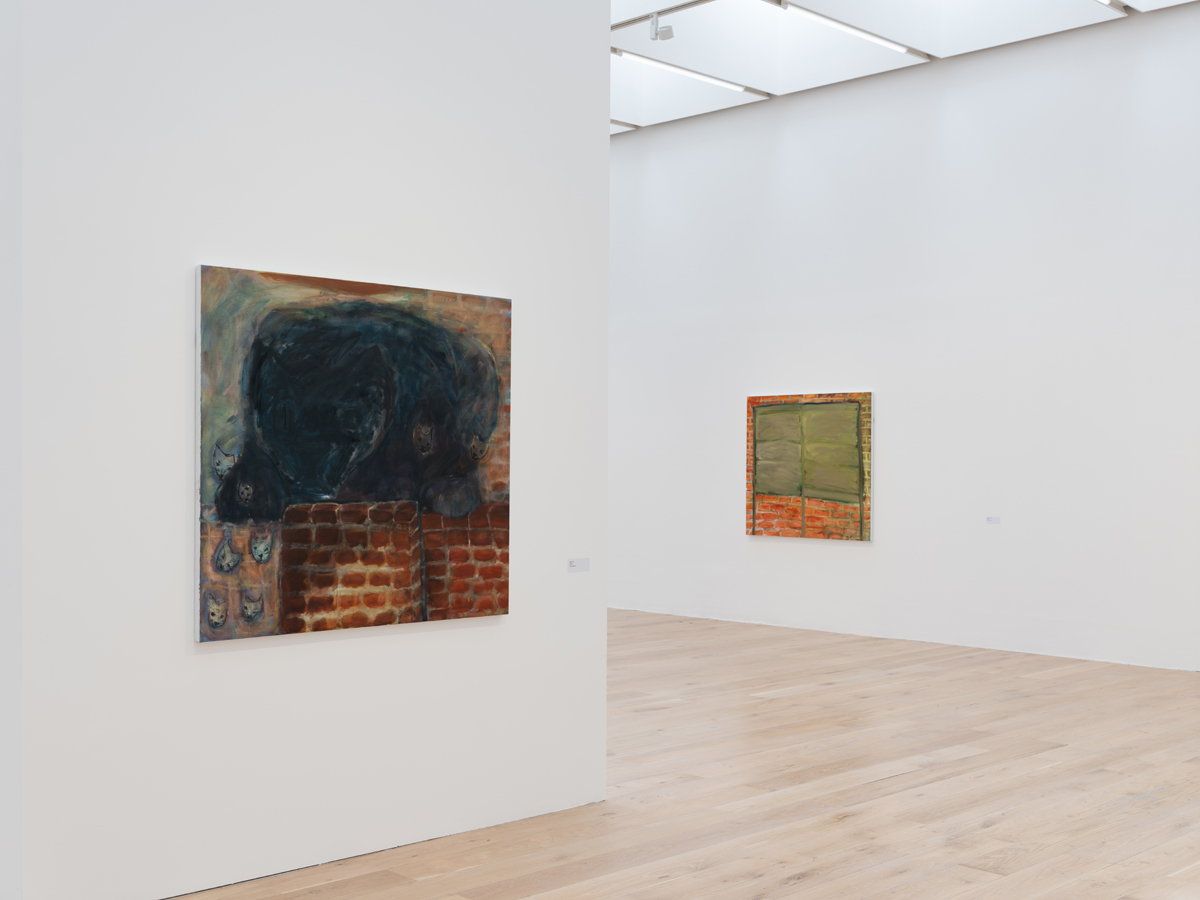
Rosalind Nashashibi: Hooks, installation view. Courtesy Nottingham Contemporary. © Lewis Ronald. Pictured, right: Shone Upon, 2022.
Some of the visual strategies employed in Nashashibi’s canvases recall aspects of her films and photographs, with their attention to detail and duration, composition and color, questions of framing and perception. I thought of Eyeballing (2005) and Abbeys (2006), in which pareidolia faces can be glimpsed, respectively, in 16mm sequences of everyday objects and quotidian surfaces, and in black-and-white photographs of abbeys flipped upside down—their ribbed architraves like demented skeletal grins, windows like hollow eye sockets. Flash in the Metropolitan (also 2006), made with her frequent collaborator, artist Lucy Skaer, was structured by intermittent illuminations of art and artifacts in the titular institution—a disorienting reconfiguration of what we see (or don’t) in museum holdings. In 2019, Nashashibi was invited to be the inaugural artist in residence at the National Gallery in London, with an on-site studio and access to the collection, allowing her to spend time thinking about how she could relate to artists “by somehow looking through their eyes or echoing one of their shapes, or taking their proposition and going somewhere with it,” noting how “it gives you a sense of being part of history.”
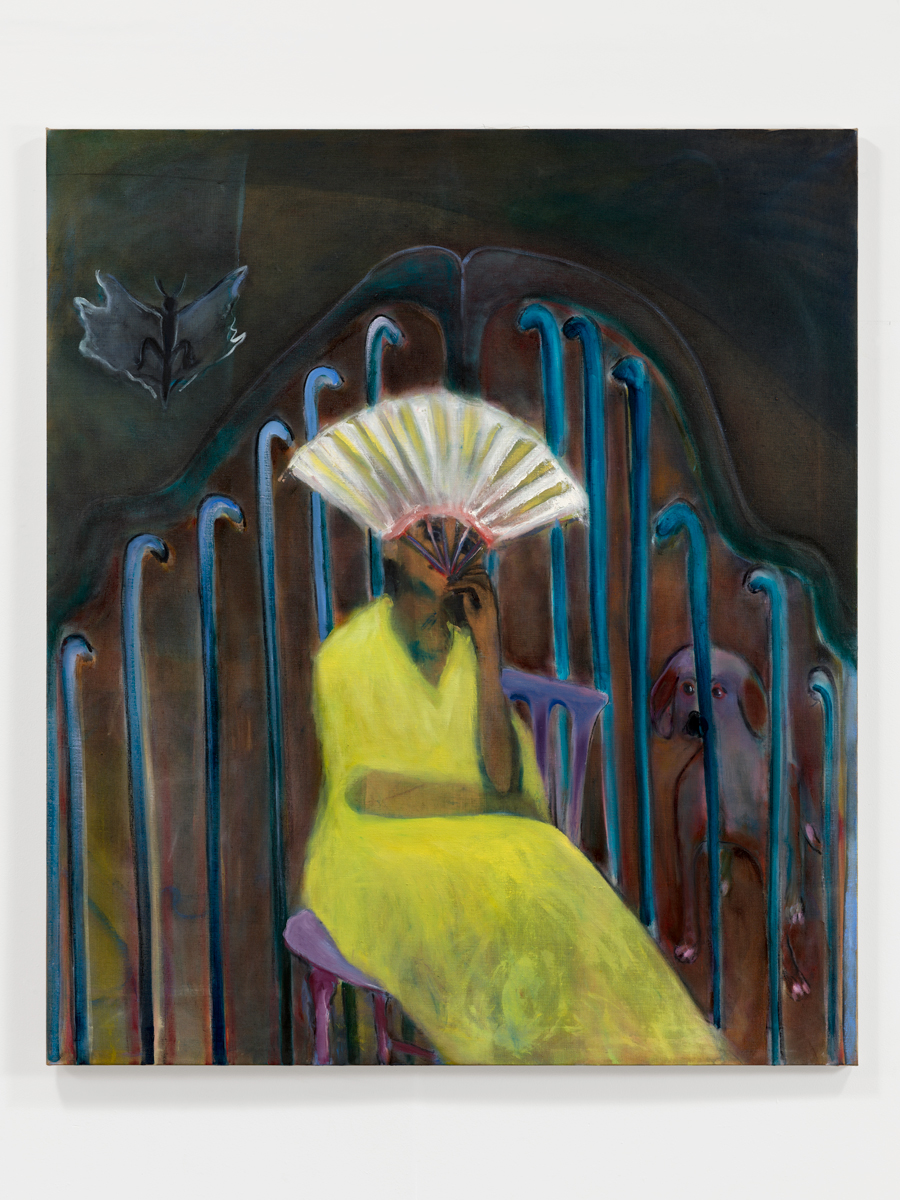
Rosalind Nashashibi, The Yellow Dress (Morisot with a Fan), 2022. Oil on linen. Courtesy the artist and GRIMM. © Rosalind Nashashibi.
At Nottingham, flashes of the past are more and less overt, and always appropriated to new ends. The Yellow Dress (Morisot with a Fan) (2022) transposes Manet’s 1872 rendering of the painter Berthe Morisot into vivid shades and a dreamlike tableau: instead of wearing black clothes in a muted domestic interior, she dons neon yellow and sits on a purple chair before a freestanding screen with electric-blue laths, holding up a lucent white fan to partially obscure her face. A playful black moth (or bat?) hovers overhead, and a lilac-hued dog peers anxiously from behind. The configuration of Joyous recognition, a smile rises up from the deep (2023) loosely recalls the predella of Paolo Uccello’s Miracle of the Profaned Host (1467–68), in which decorative red columns punctuate grisly narrative sequences. In Nashashibi’s painting, chalky horizontal swaths of gray, blue, and green are bracketed by thick mustard- and maroon-striped pillars, like parentheses or curtains that frame an indistinct scene. In the distance (or is it the foreground?) of this radically flattened image, an inverted demonic smiley face with a speech bubble offers an unfinished (but deceptively simple?) calculation: “7 ÷ 1 =”.
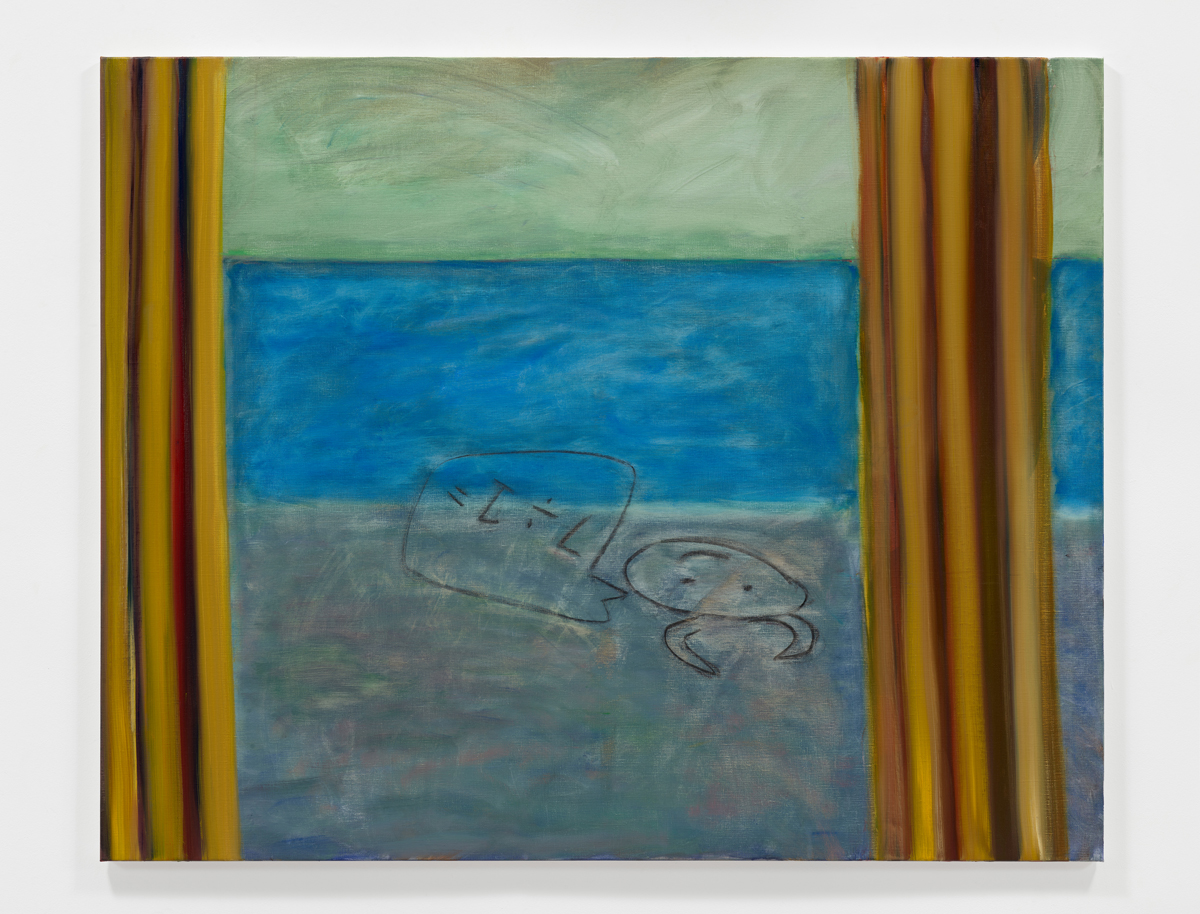
Rosalind Nashashibi, Joyous recognition, a smile rises up from the deep, 2023. Oil on linen. Courtesy the artist and GRIMM. © Rosalind Nashashibi.
The artist has said that, in comparison to her filmmaking practice, painting is a solitary activity—“me alone, me and my inner life.” In her quotation and reinterpretation of historical sources, she is also in discourse with a collective imaginary, doffing the anxiety of influence for affiliation. (As De Quincey wrote, “What else than a natural and mighty palimpsest is the human brain? Such a palimpsest is my brain; such a palimpsest, O reader! is yours.”) In Nashashibi’s canvases, painting is both experiment and exegesis, a contribution to the complex lineage of images and associations that shape every person’s vision in different and surprising ways—hooks hooking hooks hooking hooks hooking hooks—
Emily LaBarge is a writer based in London. She has written for Artforum, Bookforum, the London Review of Books, and the Paris Review, among other publications. Dog Days, a work of nonfiction, will be published in the UK by Peninsula Press in 2024. An excerpt is in the winter 2023 issue of Granta.